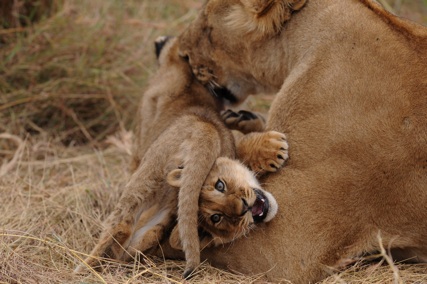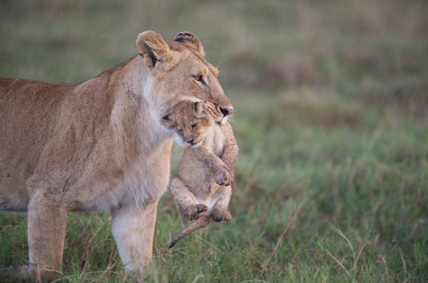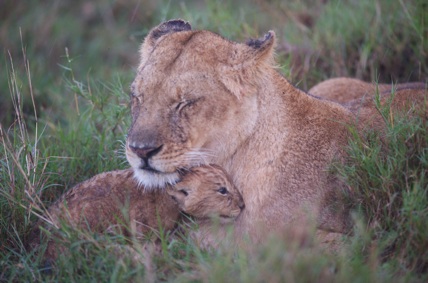Maasai Mara Reserve, March 19th, 2011, mid-afternoon.
Rain approaching from the east-northeast.
We had driven out of our tent camp after tea (and cake) and were angling northeast across the top end of Paradise Plains when I saw the distinctive long yellow-gold waving stiffly in the wind. The rains hadn’t come yet and the wildebeest were long gone now. Nothing but a lion’s mane would be long enough to wave in the wind, the grasses having either been eaten or trampled by the immense herds of wildebeest that had passed through these plains months earlier.
From my position on the roof of my land-rover I called down to Koskei, telling him to swing left, and let him know that we had lions about half a mile in front of us. I dropped down from my perch, told the guests what to expect in the next few minutes, and started preparing my own camera gear. I pulled off the 28mm-200mm zoom, and opted for a straight 300mm, F2.8 fluorite lens instead. The light would be fading fast and I’d need all the speed I could get. I bumped my ASA to 400 and poked my head back up through the roof hatch to help Koskei with our approach to the lion pride.
This pride we were quite familiar with, having spent four to eight days a month with them since the previous June. We’d watch the growing bellies of the lionesses as their synchronized pregnancies progressed, were there shortly after the kittens were born, and had repeatedly had the joy of watching the little ones tussle and play their way towards adolescence. But even now they were still only three and a half months old, months short of being able to accompany their mothers along on hunts. At this age the cubs were really nothing but trouble, and spent their days either playing, sleeping or eating (either meat or milk now).
With approached the pride slowly, circling around to the east side of the group to keep the sun behind us. Koskei, without being asked, parked a close but respectful distance from the lions, careful to keep our shadow off of them, and careful so as not to disturb them either.
We arrived among the lions a bit early, around 4:45pm, and they were still pretty much asleep; though occasionally a cub would roll over, paw or chew on another cub, and then laze back to dozing. I told my guests they’d be waking up soon, and suggested that we wait for that as the cubs would provide no end of entertainment as they roused from their day’s sleep. The family with me was quite willing to sit it out, and we settled down to a discussion about lion life and pride structure.
I used the time to teach my guests how to identify individual lions by both whisker patterns and their torn ears (the lions torn ears, not my guest’s!). I had my group draw out a few whisker patterns to make sure they understood the system, and we settled back and watched the cubs gradually wake to the world.
Within thirty minutes or so the “show” was in full swing and we were laughing, pointing out this cub or that one as they got more and more active, eventually attacking pretty much everything; everything, whether it moved or not.
The poor mothers, no end of patience, just lay there, sometimes nursing a cub, any cub (lionesses communally nurse and seldom discriminate between cubs that are their own offspring and cubs that are not when the little ones are nursing,). The lionesses, huge compared to the cubs, endured attack after attack from the little golden fur balls, sometimes rather suddenly pinning down some cub and subjecting it to a full bath, in spite of that cub’s vocal protests and squirming efforts to escape.
The light softened into photographic perfection and we were all so busy shooting and laughing that we didn’t really notice the darkening clouds to the northeast. I did notice, however, that one lioness didn’t really partake much in any of the rambunctious behavior.
Suddenly the sky darkened ominously, the temperature must have dropped an easy ten degrees in just minutes, and the clouds were upon us. Even the cubs crowded closer to their mothers, perhaps for warmth, perhaps to quell their worries as the lightening started to split the sky and the thunder began to bounce off the Iseria escarpment.
The lioness that had that hadn’t participated in the rough-housing rose quietly to her feet and almost slipped away unnoticed, heading south across the open grassland, with patient determination.
She walked with such purpose, even in the first few hundred feet, that I strongly suggested that we leave and discreetly follow her. My guests, most understandably, were not keen to leave the pride but reluctantly agreed, and Koskei, who had been listening in, was more than ready to go. Both Koskei and I just “felt” that something was going on and that we just didn’t know what it was yet.
As the big female headed southeast we flanked her, staying at least five hundred yards to the northeast of her, hoping she would not notice, or at least mind, our presence. She didn’t give a second look and plodded, with that loose-foot stride that all lions walk with.
Fifteen minutes later, just as the rain line overtook us and her simultaneously, she reached a deep gully, perhaps twenty feet across and ten feet deep. Without hesitation she slid over the lip of the drop and was gone from our sight, as of she had never been there at all.
Just as we drove up to where we had last seen her she reemerged, on our side of the “lugga” still, but this time with what we thought was a small kill, or piece of a kill, in her maw. The lioness, with the same purposeful stride, now headed straight north out onto the treeless plains and as we caught up with her we could, to our great joy, see that she was not carrying a kill, but very much the opposite. She had a small lion cub clamped carefully between her killer teeth. The cub hung motionless, as they always do, and, head high, the female walked on, the cub swinging like a furry pendulum cradled in her huge mouth. The rain stopped briefly as we scrambled for cameras and lenses. A few shots were managed and then the rain started in earnest.
“Mom” carefully lowered her cub to the ground, sat down herself, and the wee one immediately pushed his way under mother’s rain-sheltering chin and the two of them waited out the storm.
The light went flat on us, and the African night, hastened by the dark rains, so overran us, leaving us with no choice but to seek shelter ourselves. But we vowed to be out before first light to try and relocate mother and son.
The dawn broke clear, Venus high up to the east, with Orion almost overhead, the Milky Way fading fast but still clearly visible. We sat by the campfire, drank a few cups of coffee each, stuffing cake into our mouths between gulps, and talked about the lions, discussing how unusual it was for a lioness to stay with only a single cub (they often abandon singles, or even kill them; and then come right back into heat; and hopefully will have a larger litter.).
Within minutes, even in the dark twilight of pre-dawn, Koskei had no problem finding our pair. They had moved farther north, which we had counted on, and in no time we were on final approach when the mother rose to her feet, picked up the cub, and started walking back towards us!
The muscled lioness strolled, big-striding, right past my land-rover and returned the little one to the same gully. She stayed there with the wee boy for just over an hour, then pulled herself back up the north edge of the draw and walked the two miles or so back to the resting pride.
This will be my last safari of the season, but I’ll catch up with them in June, and be able to follow the little boy’s growth, education and developing skills all next season; can’t wait!








